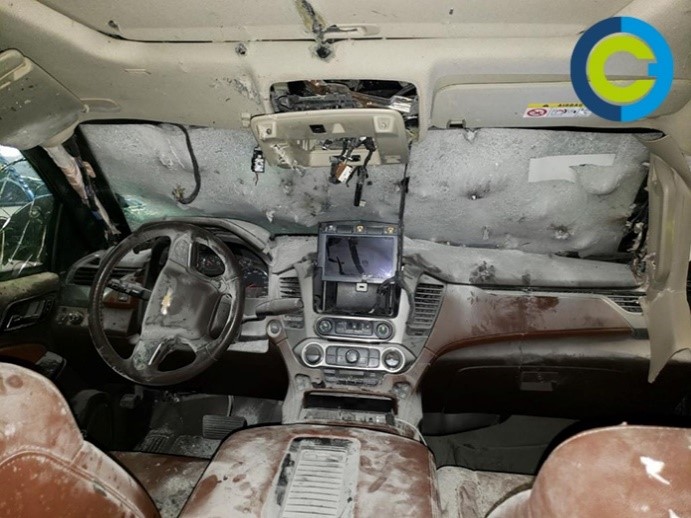A high probability of survival to an armed attack inside a vehicle is related to how good you are mastering the four elements of the vehicle security quadrant (figure 1). Therefore, the more planning and training you have in its two dimensions, the greater are the options for a successful outcome. The two elements include:
- Physical (elements and actions on the ground, mainly oriented to reactive capacity), and
- Informational (elements and actions related to threat ID and countermeasure, mainly prevention-oriented).

Modern vehicles are very complex systems that perform an essential function: Accelerated Movement. Throughout the history of the automotive industry, that function has been significantly improved. As a result, today’s cars are faster, safer, and more comfortable than ever… while you’re not under attack!

Security Driver = The Main Obstacle
As any security driving practitioner knows: “Stop the vehicle. Stop the driver. Backward works too.” The attackers will always consider the driver as the main obstacle to accomplish their mission. In that sense, the primary purpose of their tactics will be to:
- Intervene the accelerated movement (stop the vehicle), and
- Disable the driver’s capacity to operate the vehicle (stop the driver).
Both actions would be effortless to achieve against a standard driver in a non-armored vehicle. That’s the importance of trained security drivers and armored vehicles. But don’t get confused. We just bought time.
The time that was not enough, during an ambush on June 26th, 2020, for the driver and the SD of Omar Garcia Harfuch, who serves as Head of Public Security of Mexico City (figures 2&3).

But here come the two 1-million-dollar questions:
- How much time is enough, and
- How to achieve it?
There are as many answers as possible scenarios, but there are some hints we can put together as an initial pillar for discussion and consensus.
According to our regional experience on the American continent and our close relationship with colleagues worldwide, an urban executive protection scenario for a sicario-type or kidnapping mission would mainly occur at very low speed or full stop.
In the event of a chase, the most important information gathered is that the average armed persecution does not usually extend beyond 5 miles (8 km). The correlation to speed and time will vary based on traffic volume and the attacker’s plan, tactics, and equipment.
So the first principle is the following. The driver needs to keep the armored vehicle moving at least for 5 miles. If possible, avoiding exceeding 50 MPH when most commercial vehicles reach their top lateral acceleration capability and tight emergency maneuvers could result in a crash.
Run-Flats and Security Driving
Besides driver’s skills in emergencies in front of the steering wheel, tires are the other key component of mobility. Specifically, properly inflated tires. They are the interface between all vehicle systems, driver’s actions, and the terrain.
The main problem is that tires are very vulnerable to deflation or blowout in these scenarios. It could be a bullet, caltrops, road debris, an elevated sidewalk, or a natural obstacle. Suddenly, you have no air pressure in one or more tires. Your accelerated movement is partial or totally over.
These are the domains of extended mobility or run-flat devices, which have the purpose of providing the extra miles you need to get out of the X. A basic classification: sealants, run-flat tires, and run-flat inserts, and a quick list with real examples:
- Tire sealants, e.g., Slime Fibro-Seal.
- Run-flat tires, e.g., Bridgestone RFT, Goodyear EMT, Michelin ZP, etc.
- Steel belts or bands, e.g., Tyron Multiband.
- Polymer or plastic run-flat inserts, e.g., Hutchinson RRF.
- Elastomer or rubber run-flat inserts, e.g., Flats Over RV Safety Band.
As the names suggest, tire sealants are basically liquid-based chemicals that react inside the tire as an air “clotting” agent for small punctures in the tire’s tread. Run-flat tires are standard tires with extra density in their sidewalls, which allow them to work without air pressure for several miles.
In Conclusion
Neither tire sealants manufacturers nor their RF tires counterparts advertise their products for vehicle security or relate them to any post-ballistic event performance.
The opposite applies to run-flat inserts (figure 4), devices fitted to the drop center or well off the rim, and beneath the tire that in the event of complete deflation or blowout prevents the tire’s beads from coming off the rim. Additionally, they provide height support to prevent direct contact between the wheel edge and the terrain avoiding structural damage or a rollover.

Stay tuned for Part 2 with more detailed information about run-flats for civilian armored vehicles.





